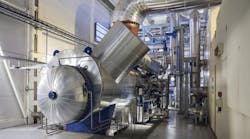The past five years have seen major product enhancements to vortex flowmeters. One perennial problem with vortex flowmeters has been susceptibility to vibration error. Vibrations in the line can cause a vortex flowmeter to falsely generate a vortex signal, or to incorrectly read an existing vortex. Suppliers have responded by implementing software and electronics, including digital signal processing, that have reduced the susceptibility of vortex meters to interference from vibration.
Another important product enhancement is the introduction of reducer vortex meters. Reducer vortex flowmeters have a reduced diameter in the center of the pipe, where the bluff body generates vortices. This reduced diameter results in a speeded up flowstream where the pipe narrows. The introduction of reducer vortex models has simplified vortex flowmeter installation and has improved the ability of vortex flowmeters to provide accurate measurement at low flowrates.
The growing availability of multivariable vortex flowmeters is also helping boost sales of vortex flowmeters. Sierra Instruments (www.sierrainstruments.com) introduced the first multivariable vortex flowmeter in 1997. This flowmeter included an RTD temperature sensor and a pressure transducer. By using information from these sensors, together with detection of vortices generated, the flowmeter can output volumetric flow, temperature, pressure, fluid density, and mass flow. Multivariable flowmeters measure more than one process variable, and typically use this information to compute mass flow. This makes the flowmeter measurement more accurate in changing temperature and pressure conditions.
In the past 10 years, a number of new suppliers have brought out their own multivariable vortex flowmeters. These include ABB, Yokogawa, KROHNE, EMCO, and Endress+Hauser. Even though multivariable flowmeters are somewhat more expensive than their single-variable counterparts, they enable users to obtain significantly more information about the process than single-variable volumetric meters. This additional information can result in increased efficiencies that more than make up for the additional cost of the multivariable flowmeter.
Vortex flowmeters are widely used for measurement of gas flow. Custody transfer of natural gas is a fast-growing market, especially with the increased popularity of natural gas as an energy source. Natural gas changes hands, or ownership, at a number of points between the producer and the end-user. This changing of hands occurs at custody-transfer points, and it is highly regulated by the American Gas Association (AGA, www.aga.org) and the American Petroleum Institute (API, www.api.org). Some other geographic regions have their own regulatory bodies.
In January 2007, an API committee approved a draft standard for the use of vortex flowmeters for custody transfer of liquid and gas. This approval is likely to boost sales of vortex meters over time, as suppliers develop products that conform to the standard. The standard was updated in 2010 and includes liquid, steam and gas. While this standard has not yet had a substantial impact, it is likely that it will increase the use of vortex meters for petroleum liquids over time.
For more research information on vortex flowmeters, visit FlowVortex.com.
Flow Research recently published the latest update of its “Volume X: The World Market for Flowmeters,” highlighting trends in flow measurement worldwide. For details, visit FlowEverything.com.


